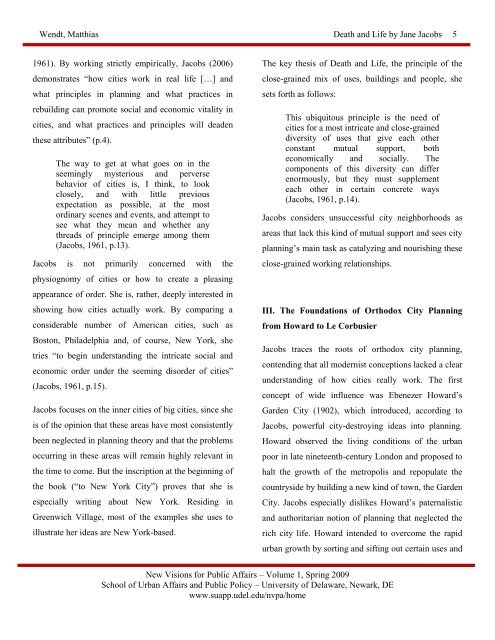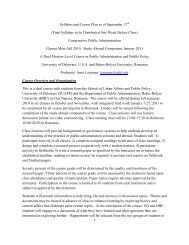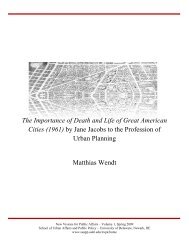New Visions for Public Affairs Volume 1 - School of Public Policy ...
New Visions for Public Affairs Volume 1 - School of Public Policy ...
New Visions for Public Affairs Volume 1 - School of Public Policy ...
You also want an ePaper? Increase the reach of your titles
YUMPU automatically turns print PDFs into web optimized ePapers that Google loves.
Wendt, Matthias Death and Life by Jane Jacobs 5<br />
1961). By working strictly empirically, Jacobs (2006)<br />
demonstrates “how cities work in real life […] and<br />
what principles in planning and what practices in<br />
rebuilding can promote social and economic vitality in<br />
cities, and what practices and principles will deaden<br />
these attributes” (p.4).<br />
The way to get at what goes on in the<br />
seemingly mysterious and perverse<br />
behavior <strong>of</strong> cities is, I think, to look<br />
closely, and with little previous<br />
expectation as possible, at the most<br />
ordinary scenes and events, and attempt to<br />
see what they mean and whether any<br />
threads <strong>of</strong> principle emerge among them<br />
(Jacobs, 1961, p.13).<br />
Jacobs is not primarily concerned with the<br />
physiognomy <strong>of</strong> cities or how to create a pleasing<br />
appearance <strong>of</strong> order. She is, rather, deeply interested in<br />
showing how cities actually work. By comparing a<br />
considerable number <strong>of</strong> American cities, such as<br />
Boston, Philadelphia and, <strong>of</strong> course, <strong>New</strong> York, she<br />
tries “to begin understanding the intricate social and<br />
economic order under the seeming disorder <strong>of</strong> cities”<br />
(Jacobs, 1961, p.15).<br />
Jacobs focuses on the inner cities <strong>of</strong> big cities, since she<br />
is <strong>of</strong> the opinion that these areas have most consistently<br />
been neglected in planning theory and that the problems<br />
occurring in these areas will remain highly relevant in<br />
the time to come. But the inscription at the beginning <strong>of</strong><br />
the book (“to <strong>New</strong> York City”) proves that she is<br />
especially writing about <strong>New</strong> York. Residing in<br />
Greenwich Village, most <strong>of</strong> the examples she uses to<br />
illustrate her ideas are <strong>New</strong> York-based.<br />
The key thesis <strong>of</strong> Death and Life, the principle <strong>of</strong> the<br />
close-grained mix <strong>of</strong> uses, buildings and people, she<br />
sets <strong>for</strong>th as follows:<br />
This ubiquitous principle is the need <strong>of</strong><br />
cities <strong>for</strong> a most intricate and close-grained<br />
diversity <strong>of</strong> uses that give each other<br />
constant mutual support, both<br />
economically and socially. The<br />
components <strong>of</strong> this diversity can differ<br />
enormously, but they must supplement<br />
each other in certain concrete ways<br />
(Jacobs, 1961, p.14).<br />
Jacobs considers unsuccessful city neighborhoods as<br />
areas that lack this kind <strong>of</strong> mutual support and sees city<br />
planning’s main task as catalyzing and nourishing these<br />
close-grained working relationships.<br />
III. The Foundations <strong>of</strong> Orthodox City Planning<br />
from Howard to Le Corbusier<br />
Jacobs traces the roots <strong>of</strong> orthodox city planning,<br />
contending that all modernist conceptions lacked a clear<br />
understanding <strong>of</strong> how cities really work. The first<br />
concept <strong>of</strong> wide influence was Ebenezer Howard’s<br />
Garden City (1902), which introduced, according to<br />
Jacobs, powerful city-destroying ideas into planning.<br />
Howard observed the living conditions <strong>of</strong> the urban<br />
poor in late nineteenth-century London and proposed to<br />
halt the growth <strong>of</strong> the metropolis and repopulate the<br />
countryside by building a new kind <strong>of</strong> town, the Garden<br />
City. Jacobs especially dislikes Howard’s paternalistic<br />
and authoritarian notion <strong>of</strong> planning that neglected the<br />
rich city life. Howard intended to overcome the rapid<br />
urban growth by sorting and sifting out certain uses and<br />
<strong>New</strong> <strong>Visions</strong> <strong>for</strong> <strong>Public</strong> <strong>Affairs</strong> – <strong>Volume</strong> 1, Spring 2009<br />
<strong>School</strong> <strong>of</strong> Urban <strong>Affairs</strong> and <strong>Public</strong> <strong>Policy</strong> – University <strong>of</strong> Delaware, <strong>New</strong>ark, DE<br />
www.suapp.udel.edu/nvpa/home







